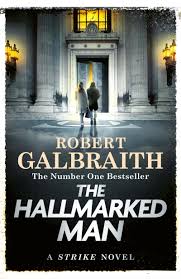 The Hallmarked Man by Robert Galbraith is the eighth book in the Cormoran Strike and Robin Ellacott series. This instalment sees the detective duo investigate the identity of a dismembered corpse in the vault of a silver shop. Decima Mullins hires the agency to confirm if the body is that of her boyfriend, Rupert Fleetwood, but Strike and Ellacott discover that the identity could also fit three other missing people – a young mechanic, an ex-paratrooper and an actor in adult films. I don’t mind a knotty plot, but I think this case had one too many threads, and three mysteries rather than four would have been easier to follow. Nevertheless, I always find the Galbraith books to be so enjoyable to immerse myself in, even if the finer labyrinthine details are difficult to hold together in my head. There are significant developments in Strike and Ellacott’s personal lives in this book, and it’s reassuring to hear that work on book number nine is well under way, given that The Hallmarked Man ends on what can only be described as the mother of all cliffhangers as the longest will-they-won’t-they saga in literary history appears to be finally heading towards some sort of resolution.
The Hallmarked Man by Robert Galbraith is the eighth book in the Cormoran Strike and Robin Ellacott series. This instalment sees the detective duo investigate the identity of a dismembered corpse in the vault of a silver shop. Decima Mullins hires the agency to confirm if the body is that of her boyfriend, Rupert Fleetwood, but Strike and Ellacott discover that the identity could also fit three other missing people – a young mechanic, an ex-paratrooper and an actor in adult films. I don’t mind a knotty plot, but I think this case had one too many threads, and three mysteries rather than four would have been easier to follow. Nevertheless, I always find the Galbraith books to be so enjoyable to immerse myself in, even if the finer labyrinthine details are difficult to hold together in my head. There are significant developments in Strike and Ellacott’s personal lives in this book, and it’s reassuring to hear that work on book number nine is well under way, given that The Hallmarked Man ends on what can only be described as the mother of all cliffhangers as the longest will-they-won’t-they saga in literary history appears to be finally heading towards some sort of resolution.
 I read the new memoir Fires Which Burned Brightly by Sebastian Faulks alongside the author’s 2007 novel Engleby. The ten chapters (or rather essays) cover various parts of his life, including his career in journalism, his relationship with alcohol, a gap year in France, mental health and his book tour across the United States after Birdsong was published. Fires Which Burned Brightly is a reluctant, almost cagey sort of book and this is particularly apparent in the chapter about his boarding school years which is partly written in the third person. I got the feeling that Faulks’s arm had been twisted by his editor to reveal more than he may have wanted to in parts, and he never seems sure how much to reveal about his loved ones or himself, but his reticence only made this book more intriguing to read. Many thanks to Hutchinson Heinneman for sending me a review copy of Fires Which Burned Brightly via NetGalley.
I read the new memoir Fires Which Burned Brightly by Sebastian Faulks alongside the author’s 2007 novel Engleby. The ten chapters (or rather essays) cover various parts of his life, including his career in journalism, his relationship with alcohol, a gap year in France, mental health and his book tour across the United States after Birdsong was published. Fires Which Burned Brightly is a reluctant, almost cagey sort of book and this is particularly apparent in the chapter about his boarding school years which is partly written in the third person. I got the feeling that Faulks’s arm had been twisted by his editor to reveal more than he may have wanted to in parts, and he never seems sure how much to reveal about his loved ones or himself, but his reticence only made this book more intriguing to read. Many thanks to Hutchinson Heinneman for sending me a review copy of Fires Which Burned Brightly via NetGalley.
 Engleby tells the story of Mike Engleby, a socially awkward young man who wins a scholarship to “an ancient” university in the 1970s and becomes infatuated with Jennifer Arkland, a girl from another college who later goes missing. Having read Faulks’ memoir, the novel clearly draws on some of the settings of his experiences earlier in life – boarding school, university studies at Cambridge and a career in journalism – but with a revelation three-quarters of the way through that forces the reader to re-evaluate everything they have just read. It’s a clever and suspenseful psychological character study, and an excellent accompaniment to read alongside Faulks’s memoir.
Engleby tells the story of Mike Engleby, a socially awkward young man who wins a scholarship to “an ancient” university in the 1970s and becomes infatuated with Jennifer Arkland, a girl from another college who later goes missing. Having read Faulks’ memoir, the novel clearly draws on some of the settings of his experiences earlier in life – boarding school, university studies at Cambridge and a career in journalism – but with a revelation three-quarters of the way through that forces the reader to re-evaluate everything they have just read. It’s a clever and suspenseful psychological character study, and an excellent accompaniment to read alongside Faulks’s memoir.
 Mark Kermode’s Surround Sound by Mark Kermode and Jenny Nelson offers a deep dive into the world of film music. Kermode presented a programme about soundtracks on the now-defunct station Scala Radio with Nelson as lead producer. Their co-written book covers various film and music genres, the early days of cinema when film scores were played live in venues usually over short films, and how some composers develop close working relationships with certain directors. The chapters are interspersed with short appreciations of Kermode’s favourite soundtracks including Drive My Car, Never Let Me Go and Blade Runner. Learning more about the process of writing and recording scores from this book has enhanced my appreciation of film music. Kermode is a brilliant critic, clear and so enthusiastic about his subject that even some of the more technical discussions about vocoders are still entertaining.
Mark Kermode’s Surround Sound by Mark Kermode and Jenny Nelson offers a deep dive into the world of film music. Kermode presented a programme about soundtracks on the now-defunct station Scala Radio with Nelson as lead producer. Their co-written book covers various film and music genres, the early days of cinema when film scores were played live in venues usually over short films, and how some composers develop close working relationships with certain directors. The chapters are interspersed with short appreciations of Kermode’s favourite soundtracks including Drive My Car, Never Let Me Go and Blade Runner. Learning more about the process of writing and recording scores from this book has enhanced my appreciation of film music. Kermode is a brilliant critic, clear and so enthusiastic about his subject that even some of the more technical discussions about vocoders are still entertaining.







